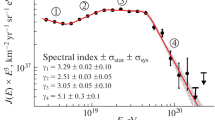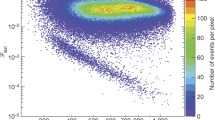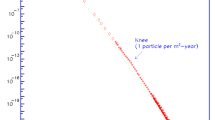Summary
In relation to the primary proton flux of very high energy ((1015÷1016) eV), the possible photon flux of equal energy created by the p-p collisions of protons with the diffused matter of the Universe, is evaluated taking into account the multiple production of the π0-mesons and their decay. If a trace of very high energy photons exists among the primary flux, two types of EAS must be produced in the air: 1) ordinary EAS; 2) pure photon-electron cascades. Taking advantage of the difference between the number of electrons produced at sea level by a protonic and by a photonic EAS of equal energy (therefore resulting in an amplification factor of the observable effect by at least ten times) it is shown that it is possible to separate these two types by studying the penetrating component with the help of a large detection area and to disclose a real limit rate as small as 10−4. Considering current cosmological estimates, it gives some possibility of observing a significant rate. This method therefore may give new experimental information on the origin of cosmic rays and on individual interaction at very high energy.
Riassunto
In relazione al flusso primario di protoni di altissima energia ((1015÷1016) eV) si valuta il possibile flusso di fotoni di uguale energia creato da collisioni p-p di protoni con la materia diffusa dell’Universo, tenendo conto della produzione multipla dei mesoni π0 e del loro decadimento. Se nel flusso primario esiste una traccia di fotoni di altissima energia, si possono produrre nell’aria due tipi di EAS: 1) EAS ordinario; 2) pure cascate fotone-elettrone. Avvalendosi della differenza fra i numeri di elettroni prodotti al livello del mare da EAS protonici ed EAS fotonici di uguale energia (dalla quale risulta un fattore di amplificazione degli effetti osservabili di almeno 10) si mostra che è possibile separare questi due tipi osservando la componente penetrante con l’ausilio di una grande area di rivelazione e determinare un rapporto limite reale sino ad un minimo di 10−4. Considerando le correnti valutazioni cosmologiche, il metodo dà qualche possibilità di osservare un rapporto significativo. Questo metodo quindi può dare nuove informazioni sperimentali sull’origine dei raggi cosmici e sulle singole interazioni di altissima energia.
Similar content being viewed by others
References
G. Cocconi:Suppl. Nuovo Cimento,8, 472 (1958).
K. Sitte:Suppl. Nuovo Cimento,8, 478 (1958).
F. J. M. Farley:Suppl. Nuovo Cimento,8, 466 (1958).
J. Heidman:Suppl. Nuovo Cimento,8, 486 (1958).
E. Schatzman:Origin and Evolution of the Worlds (Paris, 1957), p. 260.
G. T. Zatsepin:International Cosmic Ray Conference (Moscow, 1959), Abstracts pp. 15–16.
G. Puppi:Progress in Cosmic Ray Physics,3, 341 (1956).
A. Subramanian andS. D. Verma:Nuovo Cimento,13, 572 (1959).
A. Ueda andN. Ogita:Progr. Theor. Phys.,18, 269 (1957).
B. Edwards, J. Losty, D. H. Perkins, K. Pinkau andJ. Reynolds:Phil. Mag.,3, 237 (1958).
Ifη=1 this value of δ becomes seven in accordance withBudini andMolière thereforea becomes about thirty (Kosmische Strahlung,W. Heisenberg editor, Berlin, 1953).
Author information
Authors and Affiliations
Rights and permissions
About this article
Cite this article
Maze, R., Zawadzki, A. On an attempt of detection of primary cosmic photons of very high energy. Nuovo Cim 17, 625–633 (1960). https://doi.org/10.1007/BF02727552
Received:
Published:
Issue Date:
DOI: https://doi.org/10.1007/BF02727552




